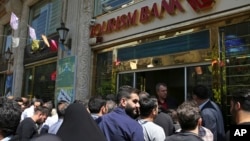Iranian authorities have arrested 12 foreign exchange traders accused of illicit dealings, in the government's latest response to the plunging value of the national currency against the dollar.
In a report published Wednesday, state news agency ISNA quoted Tehran's police chief, Hosein Rahimias, as saying the 12 currency traders had been detained in the capital the previous day on suspicion of "market disruption." Rahimi said police had seized an undisclosed amount of money from the traders and also had shut down 16 foreign exchange offices in Tehran as part of the crackdown.
Iran's rial weakened to a record low of 60,000 to the dollar on the free market this week, according to the Reuters news agency. That marked a 50 percent drop in the rial's value from a year ago.
Iranians have been selling rials and buying dollars in recent weeks on concerns that U.S. President Donald Trump will follow through on threats to pull out of a multilateral nuclear deal with Iran by next month and reimpose tough economic sanctions on their nation.
Many Iranians have been withdrawing their rial deposits from banks and nonbank credit institutions in order to buy dollars. That has left some institutions short of funds to guarantee customers' deposits.
Exiled Iranian opposition group MEK posted a YouTube video Wednesday showing what it said was residents of the southwestern city of Ahvaz protesting outside a local branch of the Melal Credit Institution earlier in the day. The protesters chanted slogans criticizing the government and demanding to know what had happened to their money.
In an earlier move to stop the rial's decline, the Iranian government unified the nation's official and free-market exchange rates on Monday into a single rate of 42,000 rials to the dollar. Iranian Vice President Eshaq Jahangiri warned that people trading dollars above the set rate would be severely punished.
Iranian Ayatollah Naser Makarem Shirazi, a prominent Shiite religious leader, recently called for the execution of currency traders found to be operating illegally, to try to deter black market activity.
Shahram Bahraminejad of VOA's Persian Service contributed to this report.







